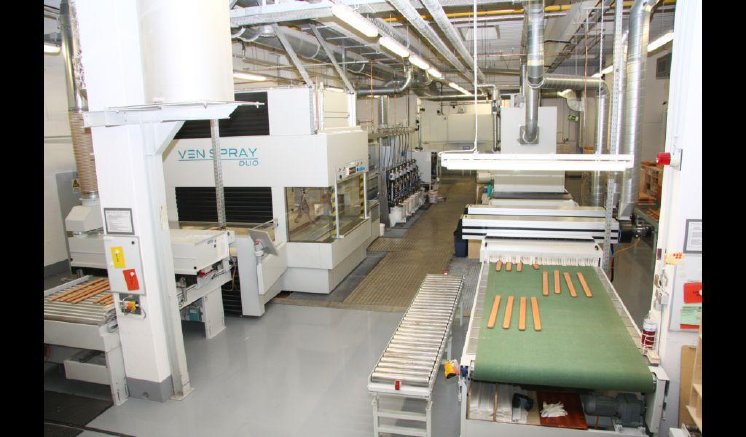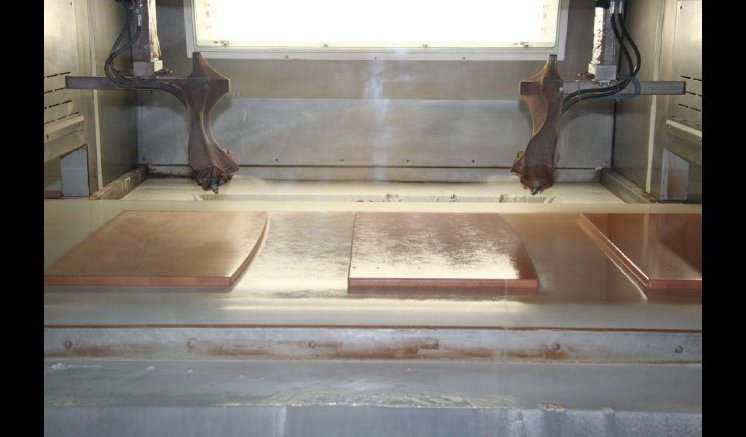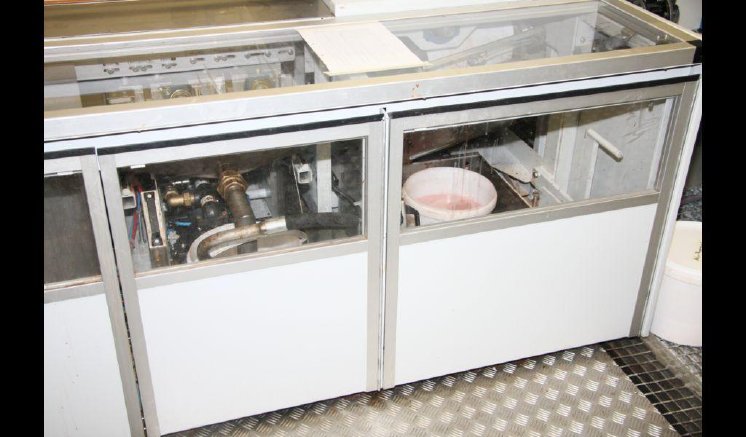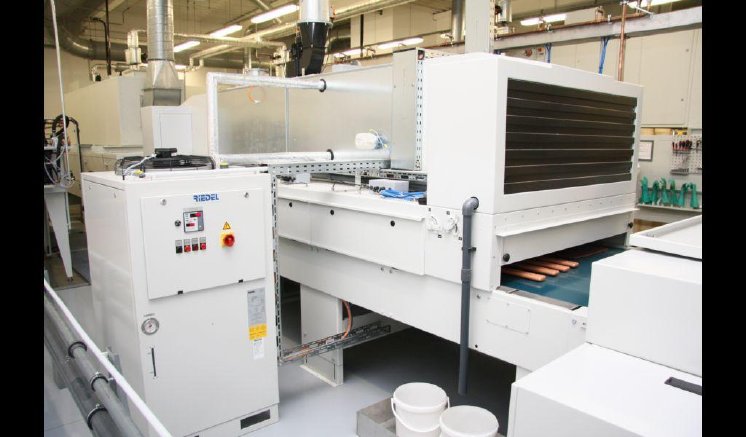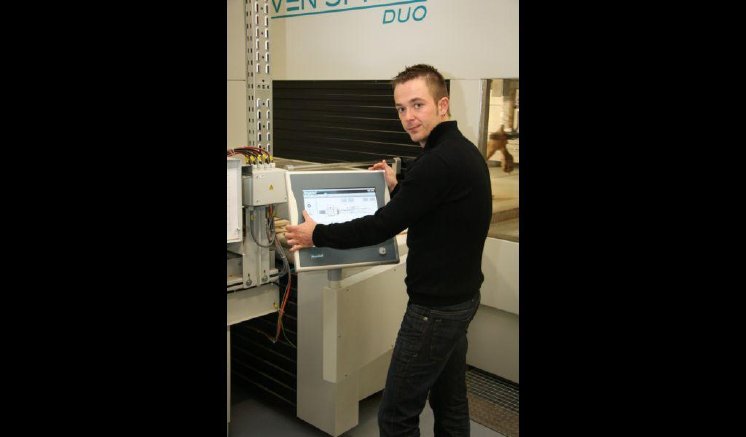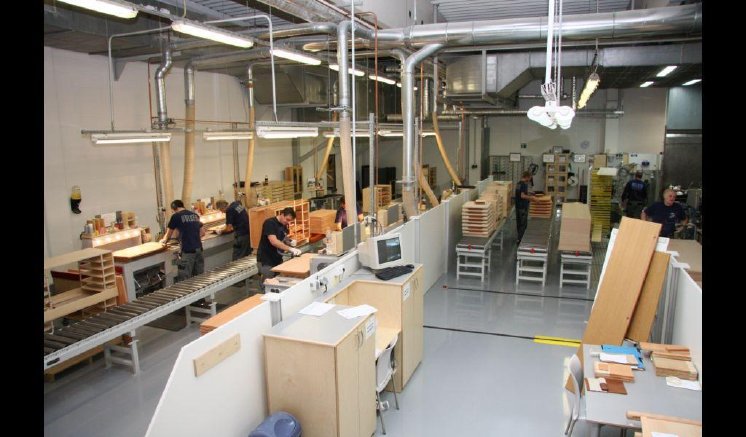That was 15 years ago. And so it was time to update this part of the Völker factory to the current state-of-the-art technology. "While some companies have scaled back their investments, we are securing our future through continuous improvement processes," company CEO Heinrich Völker explains the decision in favour of the new machine line. The reason that the company from Witten is placing its trust in Venjakob is not only due to the good experiences in recent years. Völker operating manager Jörg Waldeyer states: "The overall proposal met our requirements precisely. With the machine line concept from Venjakob, we can implement order-related manufacturing, in which smaller batches are increasingly placing special requirements on flexibility." Presently, 200 employees at Völker AG are manufacturing 150 nursing beds and furniture items per day.
The coating is a critical element in the overall process.
Since the new coating line is a critical element within the entire manufacturing process, development took place from "bottom to top". This means, that in an intensive workshop, the employees responsible for the surface technology have defined the requirements placed on the new unit down to every last detail. Lean production and insights from the automotive industry served as the basis. Völker has oriented itself toward their manufacturing methods for a long time, since many processes are transferable - not only because the Völker products are also on wheels.
Particular attention was paid to the optimisation of the material flow according to the flow principle. The products are in constant flow during the manufacturing process - from material input to final assembly and on to dispatch. A smooth interaction of all processes is therefore crucial. "Previously, the material flow had no clear guidance, resulting in a lack of order and increased material stock in circulation," according to Waldeyer. Now, after the first few months in operation, the throughput time has decreased by 70 percent and the overtime hours in the surface technology station are virtually zero. In addition, the new machine line offers clear benefits in the inventory values and storage costs. We can now coat exactly as assembly takes place in the final assembly station."
The theoretical preliminary work revealed the need to renovate the entire surface processing hall prior to installing the new machines. Bright wall and floor colours create a friendly working environment, an ergonomic working height, for example of the sanding tables and trolleys, is more in keeping with protecting the spine while working.
"However, the real challenge was the schedule", Jörg Waldeyer and project manager Thomas Hein recall. "From dismantling the old machine line to commissioning/starting-up the new line, we only had 19 working days, ten of which were used to install the new coating line."
Ambitious requirements placed on the new Venjakob line
The quick paint change was listed in first place in the specifications. "A make-ready time of less than a minute was specified," recalls Christian Schulze, the Venjakob project manager responsible for Völker . "Seven different colours and one cleaning agent should always be available to allow the multitude of different customer orders to be handled seamlessly." De facto, the paint change now takes place in approx. (30) seconds.
This time is possible due to the automatic paint changing system, which Venjakob developed for the new generation of its coating line VEN SPRAY DUO. The unit is located directly on the spray gun mounting arm of the machine. The short lines result in short rinsing times, less paint loss and very short make-ready times. This now makes up to 50 paint changes possible per day - before it was only ten.
In the surface technology station at Völker, all wooden parts needed for the production of nursing beds and furniture are coated. The machine line can process parts of very different sizes. The minimum size is approx. 180 x 50 x 5 mm (L x W x H), maximum size is 2500 x 600 x 80 mm. Before the workpieces enter the actual coating unit, they are dedusted and subsequently ionised in order to prevent renewed dust attraction. The cleaning unit is installed upstream of the pre-heating channel, by means of which the workpieces are brought to a safe processing temperature prior to coating.
Increased energy efficiency in the processes
Hightech is also applied in the paint booth. This also includes a sophisticated ventilation technology, which plays an important role because of the high atomisation of water-based paints. Christian Schulze: "Due to the improved air flow, the spray mist is perfectly removed. Thus, we were able to reduce the cleaning time by 60 percent. The air management is designed such, that we can use 30 percent of the exhaust air in recirculated air mode and thus, significantly increase energy efficiency. " Handling of the paint is also efficient. The latest spray gun technology reduces the active paint consumption. Each spray gun can be individually controlled by the spray program, quick-change systems ensure easy changeover.
A state-of-the-art paint recovery system using a V-belt allows the recovery of excess material and its reuse. The doctor blade system cleans approx. 90 percent of the conveyor belt, the remaining ten percent is handled by a classic cleaning unit with water-diluted alcohol. This cleanliness is extremely important, because paint on the belt would soil the back of the workpieces. The reduction of chemicals to clean the water used in the painting process in the extraction unit is approx. 40 percent. The city of Witten also approves and issued Völker an official sewage disposal approval due to the compliance with all directives. This allows the company to return the cleaned water directly into the channel.
The quality of the water-based paint drying process is decisive
Equally crucial for top quality, as required by Völker, is the drying process. It is the quality of the drying process, which is essentially decisive for the subsequent surface result. The challenge here is to dry the substrate with particular care, yet as quickly as possible. The first station of this process at Völker is the OIR dryer from the Venjakob VEN DRY series. Here, in an unchanging climate environment with constant temperature and humidity, the water molecules in the still wet paint film are stimulated by medium-wave infrared radiation. "This ensures that the water content of the paint dries from within the paint layer, without the formation of an upper drying skin," says Schulze. "This is the first prerequisite for the quality of the final product."
The following three dryer units with jet channels were taken from the old machine line. This required synchronisation with the new components. Because the complete coating line will now be controlled through a single user-friendly touch screen. Jörg Waldeyer: "The central control system enables a precise adaptation to the overall system."
The three UV-dryers at the end of the processing chain are also from the VEN DRY program. Because round bar structures are often transported on the conveyor, the installation of a third unit was needed, which cures from below. In this manner, quality defects can be excluded at the shadow edges and curves. The latest UV technology is used. Cold light lamps presently reduce the surface temperature of the previously up to 90 degrees Celsius to only 40 to 45 degrees. This means that drying cracks in wood or the formation of bubbles under the veneer is a thing of the past.
This is made possible by a new reflector geometry, which directs little heat but in return, the total UV-radiation onto the workpiece. Furthermore, only one reflector lamp for transparent coating systems is necessary, previously two were required. Now only two reflector lamps are sufficient for the curing of pigmented coatings, previously three or even four were needed. In addition, the new reflector allowed a reduction in the reflector lamp length to 140 cm. All this adds up to an energy saving of approx. 60 percent. For problem-free drying of the different types of paints, one dryer lamp operates with gallium, the other with mercury.
Gentle handling of the material
The distinct low surface warming through the new drying system also protects the material. This is of great importance, because the individual parts of the bed run through the coating and drying process a total of four times - twice on each side. Once both sides have been coated for the first time, each wooden piece is individually sanded by hand. A necessary step because the wood fibers raise up after the first throughfeed and the surface must be smoothed. Waldeyer: "The parts do not get their final finish until they have been sanded."
Meanwhile, the Venjakob coating and drying system has been in operation for a good six months. The methodical preparations and the close cooperation of all parties involved at Völker, Venjakob and Kuper lead to the fact that there were virtually no start-up problems. "The investment came at the right time," says Jörg Waldeyer. "Now our production is secured for the future. And we can offer our customers a long-term supply of quality products, which are expected from them by their customers - residents and patients."
